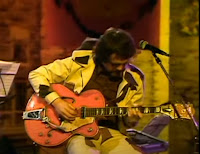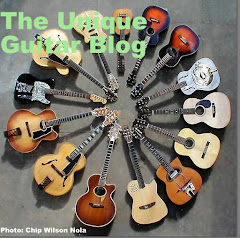 |
| Duane Eddy |
When I was about 11 years old, one of my friends had a jukebox in his dad's finished basement. It was loaded with songs from the 1950’s and early 1960’s. We could play these records for free, 'didn't even need a nickel. (My grandkids probably don't know what a nickel is.)
The one song that I played over and over was Rebel Rouser, by Duane Eddy. It was a catchy tune and had a great hook.
Eddie played this song on his electric guitars lower strings using single notes, which gave the song it's fantastic tone. At the time I had no idea about the effects used to create his guitar tone, but back then I thought, "Wow, what an amazing sound!"
Eddy started playing guitar at age 16. In three years, he purchased a Gretsch 6120 from a local music shop. To get this guitar, he traded his early 1954 Les Paul Gold top, since the Gretsch had a much different sound, plus it had that Bigsby tremolo. And this was THE signature guitar endorsed and used by Chet Atkins at the time. And it had those wonderful DeArmond pickups.
Rebel Rouser was recorded at Hazelwood’s Phoenix based Audio Records. This song was the same theme, played on the guitar’s lower strings, and the tune progressively changed keys up a half step four times.
Following Rebel Rouser, Eddy recorded a succession of hit records over the next few years. These singles included the Theme from Peter Gun, by Henry Mancini. This was written for Peter Gunn, a popular detective show that aired during the late 1950’s. A couple of other songs called Cannonball and Forty Miles of Bad Road were recorded around this same time.
In 1961 he married Country singer Jessi Colter. That same year he signed a three year contract with RCA Records.
It was 1972 when B.J. Thomas scored a hit record with the song Rock and Roll Lullaby, which was written by the famous song writing team Cynthia Weill and Barry Mann.
The recording featuring Duane Eddy and the unmistakable sound of his guitar. Also featured were The Blossoms, which were the most recorded girl group of the 1960’s, and made up of Darlene Love, Fanita James, and Jean King.
The Ron Hicklin Singers had sung back up on so many recordings, television shows , radio promotions, and movie themes. I believe they comprised most of the voices heard on The Partridge Family songs. Electric piano was played by Barry Mann.
By 1987 the LP Duane Eddy was released as a 5 CD set, with a 146 page illustrated book. This recording featured an all star cast of musicians including Paul McCartney, John Fogarty, George Harrison, Ry Cooder, David Lindley, Steve Cropper, plus original band members Larry Knechtel, and Jim Horn from Eddy’s band “The Rebels.”
Then in 2004, the Gibson Custom Art and Historic Division introduced the new Duane Eddy Signature Gibson guitar.
Duane Eddy often used a Danelectro 6 string bass on his early recordings to give that low sound
His early amplification was a Magnatone. He states the amplifier that he used was a Magnatone, but does not specify the model. Most of the Magnatone amps that I am familiar with were wonderful, clean amplifiers, but only put out 12 to 18 watts. At best these 1950's to 1960's combo models came with one or two 12" speakers. Duane states " I was plugged into a souped-up Magnatone amplifier. It ran at 100 watts and had a JBL speaker and a tweeter. It stayed clean and wouldn’t break up no matter how hard you hit the note.”
In later years, Eddy used a custom built 100 watt all tube combo amp with a 15" speaker and two channels which was built by Paul Rivera.
 |
| Rebel Rouser |
Within a few years I got an electric guitar, and Rebel Rouser was probably one of the first few songs I was able to learn to play.
Duane Eddy passed away a few days ago at the age of 86. He was a pioneer in the recording industry, especially in Country Music, and an epic guitar legend.
 |
| 1957 Gretsch 6120 |
Eddy started playing guitar at age 16. In three years, he purchased a Gretsch 6120 from a local music shop. To get this guitar, he traded his early 1954 Les Paul Gold top, since the Gretsch had a much different sound, plus it had that Bigsby tremolo. And this was THE signature guitar endorsed and used by Chet Atkins at the time. And it had those wonderful DeArmond pickups.
Duane Eddy played in a duo at the time with his friend Jimmy Delbridge and the pair had a minor hit record called "Soda Fountain Girl". This song was recorded at a studio owned by disk jockey, Lee Hazelwood. The studio did not have an echo chamber, so a 2000-gallon water tank was rigged up with microphones to act as the echo chamber.
This was a common practice back in that era for recording studios. Capitol Record’s studio’s echo was the round basement room. The original Gold Star Studio had a compliment of trapezoidal structures for it's echo chambers). It was this echo that gave Duane Eddy's guitar a huge sound. (Although not on this song.)
It is worth noting that Lee Hazelwood later became a well known producer and recording artist. He teamed up with Nancy Sinatra, writing and producing These Boots Are Made For Walking and Some Velvet Morning. But I digress.
Eddy’s first recording was Movin’ n’ Groovin’. This song featured Duane's twangy guitar with generous use of the Bigsby vibrato paired with a screaming saxophone. This formula was followed for Duane Eddy's subsequent hits. Movin' n' Groovin' hit #72 on the charts.
 |
| The Original Rebel Rouser |
Rebel Rouser was recorded at Hazelwood’s Phoenix based Audio Records. This song was the same theme, played on the guitar’s lower strings, and the tune progressively changed keys up a half step four times.
Using the same formula, and to make things interesting a saxophone part was added, along with hand claps and Rebel yells by a Doo Wop group known as The Rivingtons, These additional parts were added at a Los Angeles based studio.
Rebel Rouser became a huge hit, reaching #6 on the charts and gave Duane Eddy his first gold record. He had made a name for himself.
 |
| Peter Gunn Theme |
By 1958, Duane Eddy released his first album called Have Twangy Guitar, Wil Travel. This garnered him another gold record.
 |
| Jessi Colter & Duane Eddy |
In 1961 he married Country singer Jessi Colter. That same year he signed a three year contract with RCA Records.
Then in 1962 he scored another hit with the song (Dance With The) Guitar Man. This became Eddy’s third gold record. Duane Eddy went on to produce records for many other artists.
 |
| Rock And Roll Lullaby |
The lyrics of this recording brought up a whole list of memorable artists to evoke the feeling of a teenaged mother singing the popular songs she knew to her new born son.
 |
| The Blossoms |
Though the producers could not get the Beach Boys to sing back up for the song, they recruited three members of the Ron Hicklin Singers, including Ron Hicklin which performed the parts perfectly.
 |
| The Ron Hicklin Singers |
In 1982, Duane Eddy’s guitar was featured in the movie Grease 2 playing his song, Rebel Walk.
Eddy’s guitar was heard again in 1986 on a remake of The Peter Gunn Theme by the Advent-Garde synth pop band Art of Noise. (By all means, click on the link.)
 |
| The Duane Eddy CD |
Eddy’s guitar was heard in the movie “Forest Gump”.
And surprisingly Duane Eddy played lead guitar on Foreigner’s hit song, Until the End of Time.
Duane Eddy was the very first rock and roll guitarist to have a signature model, when in 1961 Guild Guitars introduced the Duane Eddy signature models DE-400 and the deluxe DE-500.
A limited edition of the DE-500 model was reissued briefly in 1983 to mark Eddy's 25th anniversary in the recording industry.
By 1997, 40 years after he had bought his Gretsch Chet Atkins 6120, Gretsch started production of the Duane Eddy Signature Model, the Gretsch 6120-DE.
 |
| Gibson Duane Eddy Model |
Then in 2004, the Gibson Custom Art and Historic Division introduced the new Duane Eddy Signature Gibson guitar.
A new Gretsch G6120DE Duane Eddy Signature model was released in spring 2011.
Then in 2018 Gretsch released the G6120TB-DE Duane Eddy 6-string bass model.
 |
| Duane with His Guitars 1958 |
Duane Eddy often used a Danelectro 6 string bass on his early recordings to give that low sound
Though Guild had created his 1961 Signature model, for most of his career Duane Eddy relied on his Gretsch 6120 DE model in later years. Although video exists of Eddy using both instruments.
 |
| Duane Eddy with Amplifier |
His early amplification was a Magnatone. He states the amplifier that he used was a Magnatone, but does not specify the model. Most of the Magnatone amps that I am familiar with were wonderful, clean amplifiers, but only put out 12 to 18 watts. At best these 1950's to 1960's combo models came with one or two 12" speakers. Duane states " I was plugged into a souped-up Magnatone amplifier. It ran at 100 watts and had a JBL speaker and a tweeter. It stayed clean and wouldn’t break up no matter how hard you hit the note.”
At one point, Duane played through a Fender Super Sonic 100 Combo with a two 12" speaker cabinet.
 |
| Eddy's Rivera Amplifier |
Though Duane Eddy will be forever remembered for his single note melodic work on guitar, he was a very good Travis picker, in the style of Chet Atkins.
 |
| Duane Eddy playing Cannonball Rag |
Though Duane Eddy will be forever remembered for his single note melodic work on guitar, he was a very good Travis picker, in the style of Chet Atkins.
©UniqueGuitar Publications (text only)
Click on the links below the pictures for sources
Click on the links in the text for further information













































